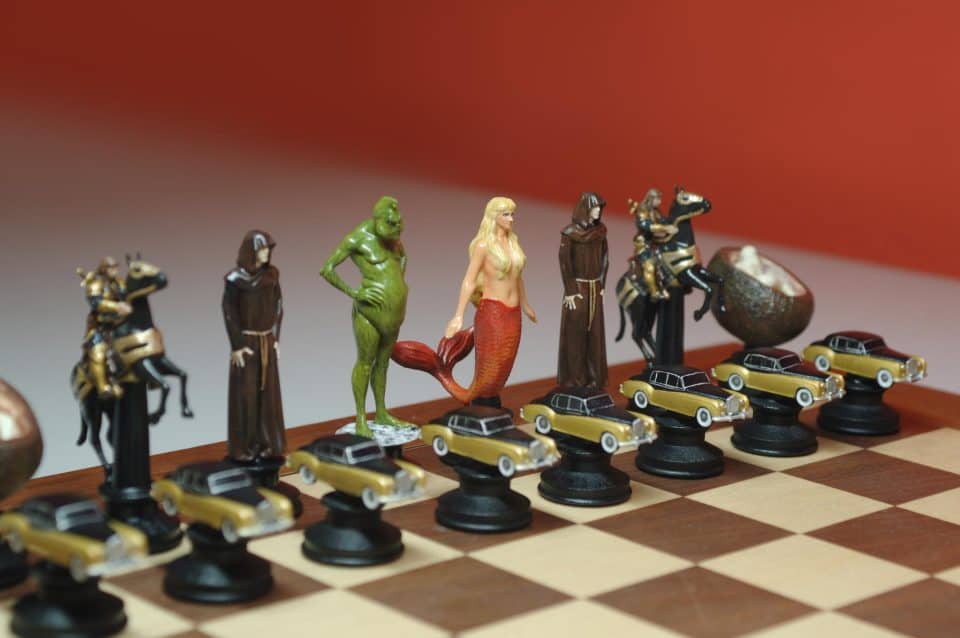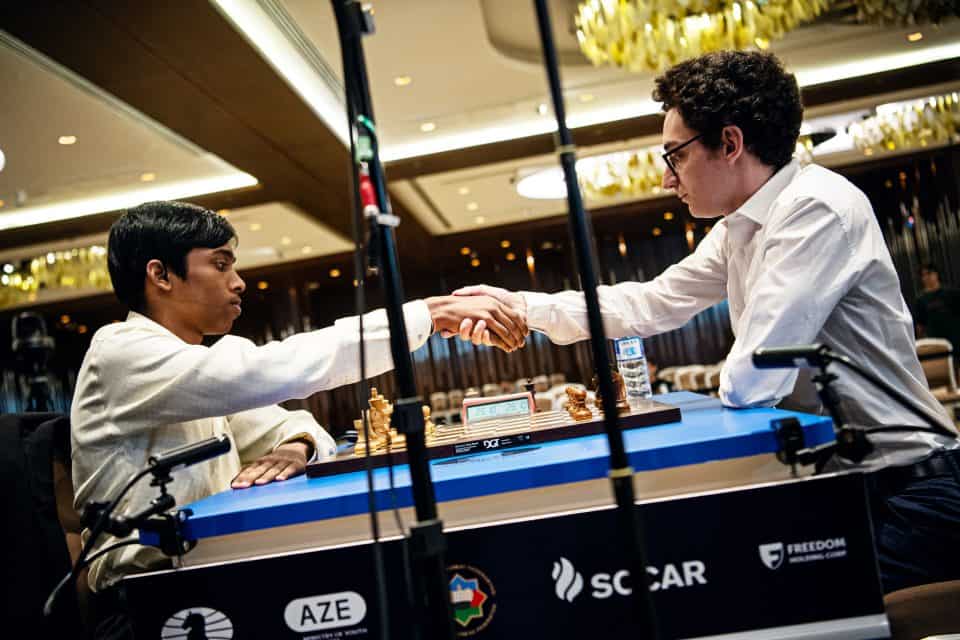If you’ve just discovered this wonderful game of chess or if you’ve been playing it for long and want to brush up on your knowledge, a glossary of useful chess terms and definitions has been compiled to provide the required familiarity to begin you on the right route.
The following are chess terms and definitions every chess player should know:
Algebraic Notation: The standard method of recording and describing chess moves using letters and numbers to indicate the squares on the chessboard. Learn about chess notations here.
Analysis: The examination of a game or a position to assess the quality of the moves and other characteristics of the game or position. After a game, the players will frequently do a game analysis. Learn how to analyze your games here.
Attacking: Initiating an aggressive move or sequence of moves to threaten an opponent’s pieces or positional weaknesses.
Back Rank: The row on the board on which the pieces (king, queen, rooks, bishops, knights) start. It is vulnerable to back-rank checkmates.
Bishop: One of the two types of minor pieces in chess, each player starts with two bishops. They move diagonally and can only stay on squares of the same color throughout the game. Learn more about how the bishop moves.
Capture: When a piece captures an opposing piece and rests on its square, it is referred to as capture. The chess notation “x” is used to represent it.
Castling: A maneuver in which the King and the Rook work together for attack and defense purposes. It’s a great measure for king safety and is the only time two pieces can move at the same time. The king moves two squares towards the rook, and the rook jumps over the king to the adjacent square. It’s written as “0-0” (short castling) or “0-0-0” (long casting). Learn more about castling here.
Center: The four squares in the middle of the chessboard (d4, d5, e4, e5) that are strategically important for piece development and control.
Check: When the King is directly threatened by an opponent piece, It’s known as a check. A player who is under check must answer immediately. The chess notation “+” is used to represent it.
Checkmate: A position in which the king is in check, and there is no legal move that can remove the threat. This results in the game being won by the opponent. The chess notation “#” is used to symbolize it.
Closed Game: A game characterized by a pawn structure where the center is blocked by pawns, limiting piece mobility.
Control: When a player has a piece or pawn occupying a square, they are said to have control over that square.
Defense: Strategies and moves employed to protect one’s pieces, pawns, and king from threats by the opponent. Learn more about defense here.
Deflection: A tactic where a defending piece is forced to leave its position, making way for an attack on a more valuable target.
Diagonal: A slanting arrangement of squares is known as a diagonal. In a diagonal, all square colors are the same.
Draw: A game result that occurs when neither player can force a win. Agreement, repetition, prolongation, or timeout can all lead to a draw. Learn more about draws here.
Endgame: The phase of the game that occurs after the middlegame, where there are fewer pieces and pawns on the board. Learn more about the endgame here.
En passant: A pawn technique that allows a pawn to capture another pawn by moving two squares on its first move. If the files of both pawns are side by side, the capture is done as if the pawn being captured had moved a square forward. Learn more about en passant here.
En prise: The capture of a hanging object is known as en prise.
Exchange: When one player captures an opponent’s piece of equal value, it is known as an exchange.
Exposed King: When a king lacks sufficient pawn cover and is vulnerable to attacks from the opponent’s pieces.
FIDE: The International Chess Federation that governs the rules and regulations of chess, as well as organizing tournaments and awarding titles. Learn more about FIDE here.
File: On the chess board, a COLUMN (VERTICAL) lettered a to h is called a file. There are eight different files in all.
Flag: A situation in which a player loses a game due to a timeout. Learn more about flagging here.
Fork: A strategy that allows one piece to directly threaten multiple pieces at once. A fork can be used by any chess piece but is usually associated with the knight.
Gambit: A chess opening in which a player sacrifices material, typically a pawn, in exchange for a strategic advantage or initiative. Learn more about gambits here.
Grandmaster: The highest title awarded by FIDE. It is given to elite chess players who have achieved a high rating and met specific performance criteria. Learn more about the title of grandmasters here.
Hang: A circumstance in which a piece with no defense is in danger of being captured.
Infiltration: The act of penetrating the opponent’s position with one’s pieces, typically to create threats or weaken the opponent’s defenses.
Initiative: The ability to dictate the flow and pace of the game, often by maintaining threats or controlling key squares.
Isolated Pawn: A pawn that has no neighboring pawns on the adjacent files. It can be a strategic weakness if not properly supported. Learn more about isolated pawns in our guide.
King: The most important piece in chess, the objective of the game is to checkmate the opponent’s king while protecting your own. Learn more about the king and how he moves here.
Knight: One of the two types of minor pieces in chess, each player starts with two knights. They move in an L-shape, consisting of two squares in one direction and one square in a perpendicular direction. Learn more about the knights and how they move here.
Middlegame: The phase of the game that occurs after the opening and before the endgame. It involves strategic planning, piece coordination, and maneuvering. Learn more about the chess middlegame here.
Open Game: A game characterized by a pawn structure where the center is open, allowing for greater piece mobility.
Opening: The initial phase of the game, where players develop their pieces, control the center, and prepare for the middlegame. Learn more about openings for the White pieces and the Black pieces.
Opening Principles: General guidelines for the early moves of a game, such as controlling the center, developing pieces, and ensuring king safety.
Passed Pawn: A pawn that has no opposing pawns to prevent its promotion to a higher-ranked piece. Learn more about passed pawns in our guide.
Pawn Structure: The arrangement of pawns on the chessboard, which can influence strategic plans and determine the weaknesses and strengths of each side.
Pin: A technique that prevents a piece from moving by threatening the piece behind it with a higher value piece. Learn more about pins here.
Promotion: A situation in which a pawn gains the ability to transform into higher pieces (except a king) after reaching the opponent’s back rank. The chess notation “=” is used to represent it.
Quiet Move: A move that does not involve an immediate capture or check but instead focuses on improving piece coordination or consolidating the position.
Queen: The most powerful piece on the chessboard. It can move in any direction, horizontally, vertically, or diagonally. Learn more about the queen and how she moves here.
Rank: On the chess board, a ROW(HORIZONTAL) numbered 1 to 8 is called a rank. There are a total of eight ranks.
Rook: One of the two major pieces in chess, each player starts with two rooks. They move horizontally or vertically across the board. Learn more about the rooks and how they move here.
Sacrifice: A deliberate move where a player willingly gives up material, such as a piece or pawn, for a strategic or tactical advantage. See the exchange sacrifice as an example.
Skewer: A strategy for gaining material by driving a more valuable piece out of the way of a less valuable piece being captured. Learn more about skewers here.
Stalemate: A situation in which a side that does not have a king on check is unable to make a legitimate move against a side that has mating material. STALEMATES ARE ALL DRAWS. Learn more about stalemate here.
Strategy: Strategy refers to the plans and principles that increase one’s chances of winning.
Tactic: Short-term sequences of moves that focus on specific threats, captures, or positional advantages. Fork, skewer, and pin are some examples of tactics. Learn more about these tactics here.
Tempo: The concept of gaining a move or forcing the opponent to make moves that do not contribute to their overall plan. Learn more about a tempo here.
Underpromotion: When a pawn is promoted to a piece other than a queen, such as a knight, bishop, or rook. Learn about underpromotion here.
Variation: A specific line of moves within a chess opening or a sequence of moves in a game.
Zugzwang: A situation in which any move a player makes will worsen their position. It is a positional disadvantage where the player would prefer to pass their turn.
We hope these definitions help you in understanding the various chess terms. If you have any further questions, feel free to ask!







join the conversation